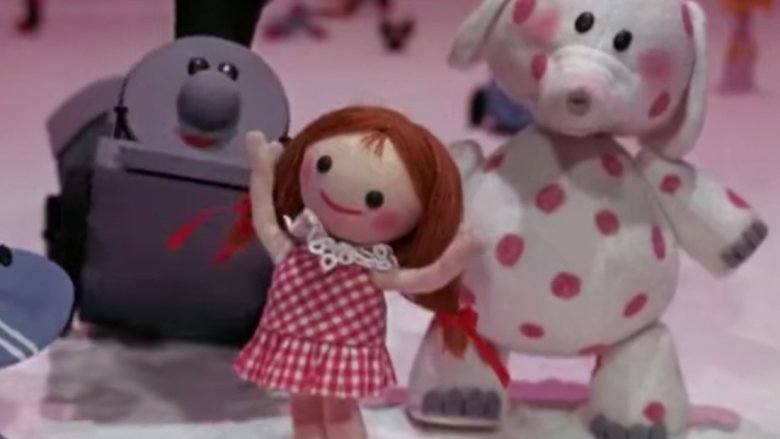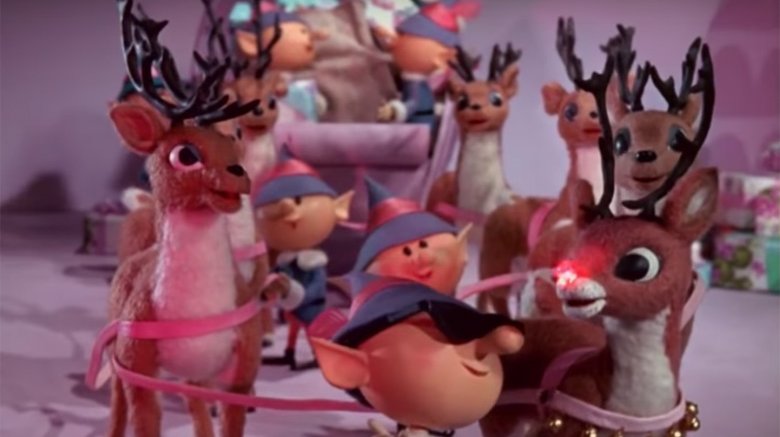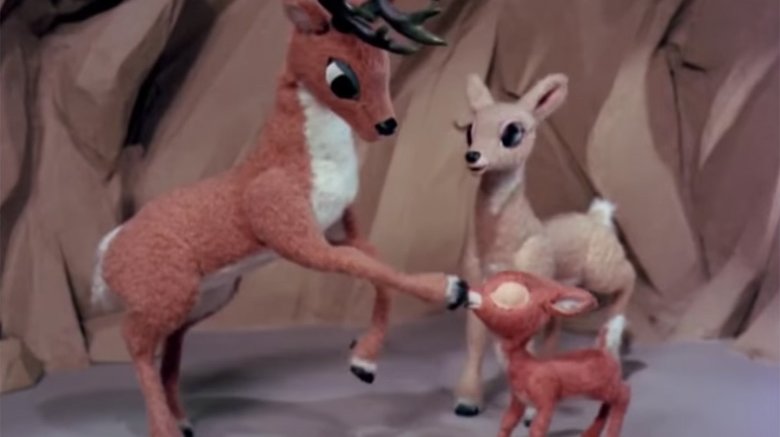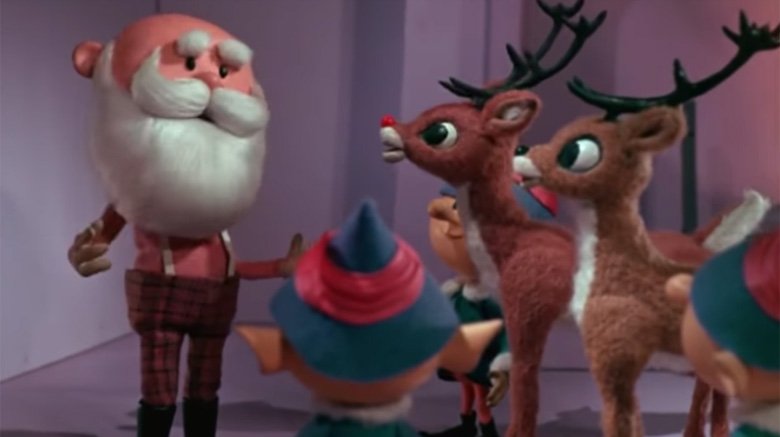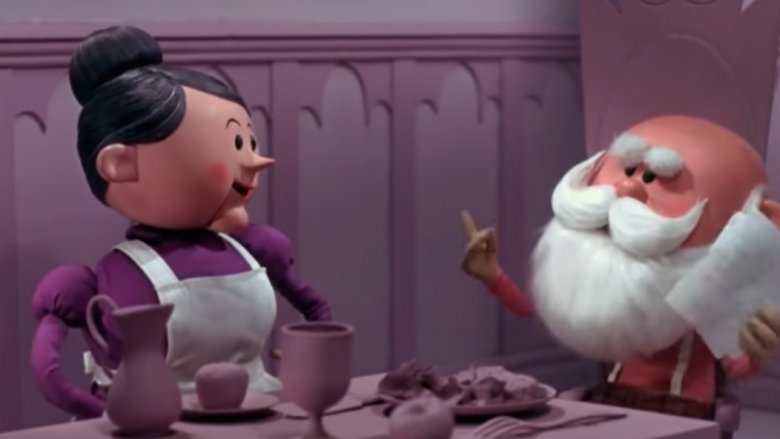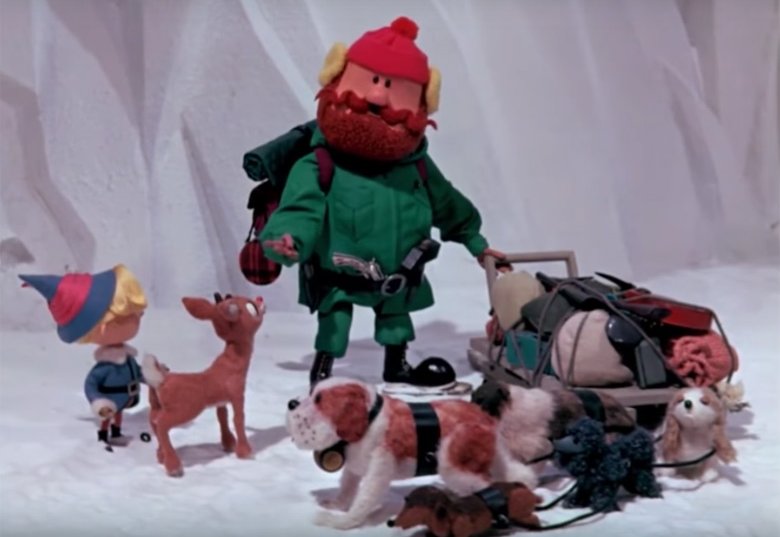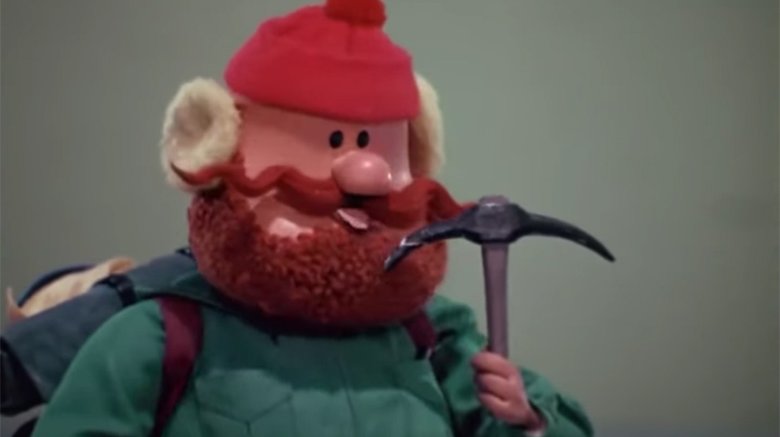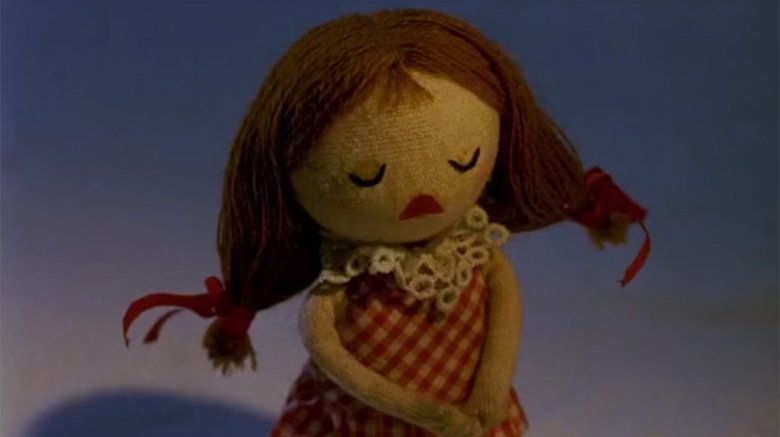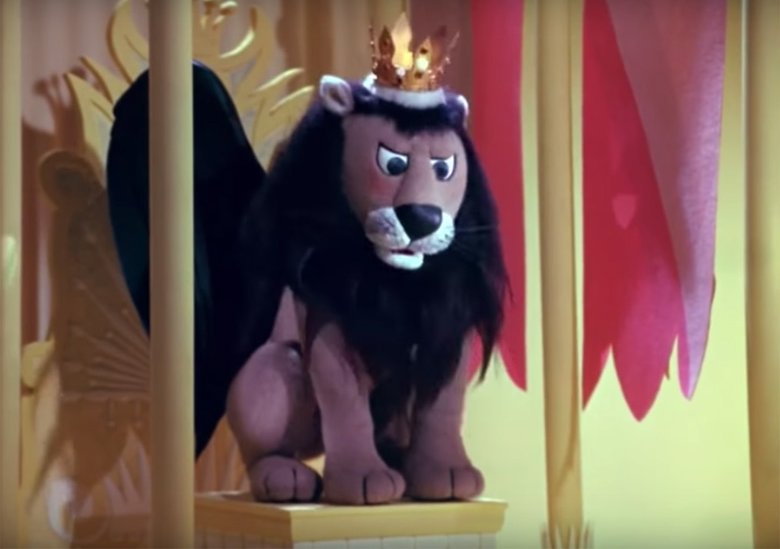Everything Messed Up About Rudolph The Red-Nosed Reindeer
You know Dasher, and Dancer, and Prancer, and Vixen, Comet, and Cupid, and Donner, and Blitzen, but do you recall the most famous reindeer of all? Well, you should — ever since it hit the airwaves in 1964, Rudolph the Red-Nosed Reindeer has become the longest-running Christmas special of all time. It's a beloved tradition that tells a story of how our differences can make us stronger, and was so well received that its producers, Rankin/Bass, spent the next 20 years focused on producing stop-motion Christmas specials that tackled everything from a donkey that was present for the birth of Christ to two completely different origins for Santa Claus.
But while it's not lacking in good cheer, Rudolph is hardly the squeaky-clean narrative you might remember. Dig a little deeper in that North Pole snow, and you'll find that there's a whole lot of messed up stuff going on.
Rudolph is only loved once his differences prove to be valuable
It's difficult to imagine being alive today and not being at least slightly familiar with the narrative laid out by Johnny Marks in his original song, but just in case, here you go: Rudolph is a reindeer born with a red nose so shiny that some would even say it glows (like a light bulb). This caused him no end of trouble as a child, with the other reindeer shunning him, but once his nose-beam proved to be capable of lighting the way for Santa Claus on a particularly foggy Christmas Eve, he was lauded by his former tormentors and went down in history (like Napoleon or toothpaste, depending on where you went to elementary school).
Side note: If you're not sure who this Santa Claus guy is and why he's riding around in a sleigh pulled by reindeer, well, c'mon. There's only so much we can explain, and you're just gonna have to meet us halfway on this one.
The problem is right there in the song: "Then how the reindeer loved him." Before his differences proved to be valuable in propping up the existing North Pole status quo, they hated him so much that they wouldn't even let him play games. It was only once they realized they could use his nose for their own benefit that they "loved" him. If red noses weren't good fog lights, it stands to reason that he would've been shunned to his dying day. To the special's credit, it does make a point to have his family out looking for him before he comes back to light the way on Christmas Eve, but maybe teaching kids that you should run away to make everyone feel bad about ridiculing you isn't a great idea.
Donner is deeply ashamed of his son
You'd expect a bully like Fireball, Rudolph's young rival, to scorn Rudolph for his differences, but at least he can count on his family for support in those trying times, right? Wrong. When the song says "all of the other reindeer," it means all of them — including his own father.
The very first thing that Donner does upon witnessing the birth of his only child — after he recoils in shock — is decide that Rudolph's nose is so shameful that it must be hidden at all costs. To that end, he smears mud on Rudolph's nose with the intent of leaving it there forever. Not only does that hide the glowing, it also stuffs up Rudolph's nose, as evidenced by the fact that voice actress Billie Mae Richards makes him sound like he has a cold for the first 15 minutes of the special. So according to Donner, Rudolph's nose is so shameful that hiding it is more important than breathing properly.
It's actually pretty hard to blame him, though. Forcing your son into the nose closet is a rough decision, but considering that when Santa Claus finally finds out, he tells Donner that he should be ashamed of himself for siring a monstrosity like Rudolph, it's easy to see why he did it. If Santa Claus is showing up to smack-talk your kid, it's safe to assume something's gone very, very wrong.
Santa has an anxiety disorder
The most notable thing about Rudolph's Santa Claus — aside from the fact that he makes a habit of showing up right after a reindeer birth to sing a song about how great he is and a willingness to overlook an entire community ostracizing one reindeer — is that when he first shows up, he's almost painfully thin.
The reason, of course, is that he's wracked with anxiety. Between the weather that's going to require the intervention of a laser-nosed mutant, the pressure of getting toys made for 1.9 billion children, and the incessantly cheerful songs being sung by the elves while they work on the toys, he's so worried about everything that he can't work up an appetite. That's worrisome enough, but the fact that Santa himself can reach his limit on Christmas cheer means the rest of us should probably feel a little better about being grumpy over the holidays.
It's worth noting that while it was definitely the first, Rudolph wasn't the only Rankin/Bass joint that would dive into Santa's mental problems. It's not quite the anxiety-ridden cruelty that we see here, but The Year Without a Santa Claus takes place during a Christmas where, as the title implies, jolly ol' Kris Kringle is so beaten-down and weary from the pressure of the holiday season that he almost quits. He sees you when you're sleeping, he knows when you're awake, and he's suffering from major depressive disorder.
Mrs. Claus fattens up her husband
Throughout Rudolph, Mrs. Claus makes attempts to get Santa to eat on a pretty much constant basis. This is understandable, given that he spends most of the special about half the size that you might expect if you've ever seen Santa Claus before. The thing is, she's not doing it for health. She's explicitly trying to fatten him up because, in her words, "they expect a fat Santa."
Between Mrs. Claus demanding that her husband literally double in size before he spends the coldest night of the year trampling over rooftops, Donner cutting off his son's air supply, and Hermey the Elf being screamed at by his boss because dentistry just isn't done — which is pretty weird when you consider how many sweets they eat up there — the North Pole is full of people who value appearance over being true to yourself. But while Donner and the elves later realize their mistakes, Mrs. Claus never does.
According to Sam the Snowman, she always has Santa fattened up in time for Christmas, which means that Santa's anxiety-fueled weight loss and Mrs. Claus cramming high-calorie food into his mouth aren't unique to this year. It's a regular occurrence, and that's just not healthy.
Yukon Cornelius is actually a terrible prospector
Make no mistake: From the moment he steps on the screen, Yukon Cornelius is a baller. Not only is he quite possibly the only beloved figure in all of Christmas mythology who's packing a six-shooter on his belt, he also mentions a shopping list of "life-sustaining supplies" that is entirely composed of cornmeal, ham hocks, gunpowder, and guitar strings. That alone makes him one of the most interesting characters in the entire Rankin/Bass canon, up to and including the wizard who battles demons with an ax that shoots laser beams.
That said, Y.C.'s description of himself as "the greatest prospector of the north" probably isn't accurate. Despite the fact that he claims his land is full of silver and gold, we never actually see him with either, and while he does help Rudolph and Hermey escape from the Bumble, his solution is arguably worse than the problem. The Bumble, at least, is a creature that can feel pain and can presumably be defeated in Combat, but Cornelius' big idea is to float off on an iceberg with no idea of where he's going, and — since he hadn't gotten around to buying the cornmeal and ham hocks just yet — no food to eat along the way. If they hadn't run smack into the Island of Misfit Toys, there's a good chance Rudolph would've been a red-nosed plate of venison.
The most telling piece of evidence, though, comes from his dogsled. As you may recall from the documentary films of Cuba Gooding Jr., sled dogs tend to be specific breeds, like huskies or Alaskan Malamutes. Team Cornelius, on the other hand, is the most mismatched bunch you could ask for, stocked up with a St. Bernard and a French poodle, among others. Admittedly, there was once a team full of poodles that competed in the Iditarod (they did not do well), but unlike Cornelius, nobody's ever tried it with Dachshunds.
A missing scene explains Yukon Cornelius' weirdest habit
Of all the weird things Yukon Cornelius does — you know, wrestling an abominable snowman, traveling across the tundra with a team of ill-trained dogs, rocking so hard that he has to buy guitar strings as often as he needs cornmeal — the strangest by far is the way that he'll often toss his pickax up into the air, pick it up, and then start rubbing his tongue on it like he's a middle schooler practicing for his first French kiss. It is, to say the least, a little concerning, especially since it's never explained why he's doing it.
At least, it's never explained if you watch the special on television every year. If you were watching the original broadcast in 1964, however — or if you're the kind of person who feels compelled to own Rudolph the Red-Nosed Reindeer because you might want to watch it in the middle of August — you know exactly why he's doing it: He's looking for a peppermint mine. It's only revealed at the end, when he actually manages to find a vein of peppermint right outside Santa's castle, retroactively explaining why viewers have seen him slobbering all over his ax for an hour every December.
Unfortunately for Cornelius and his reputation, the special runs a little long if you're making time for commercials, and CBS had to choose between keeping that scene or the scene where Santa Claus actually makes good on his promise to take the Misfit Toys to their new homes. It's not surprising they decided Santa's rep was a little more important than the prospector's, and while the scene is still included on home video versions, it's been left off every single broadcast since 1965.
Dolly has depression
For the most part, the residents of the Island of Misfit Toys are pretty self-explanatory, although the fact that a stuffed elephant wound up there just for sporting polka dots leads us to believe there were some pretty harsh kids back in 1965. The one misfit that has always perplexed viewers, though, is Dolly, a doll that seems completely normal in every respect.
In a 2005 interview with the Archive of American Television, producer Arthur Rankin Jr. confirmed what viewers had long suspected. Unlike the train with square wheels or the water pistol that only shoots jelly, Dolly's problem is neither obvious nor physical. It's psychological. After being abandoned by the girl who owned her, Dolly developed a severe depression, something that's only more heartbreaking when you realize she's still referring to herself as "a Dolly for Sue." Because an anxiety-ridden Santa and a reindeer consumed by shame just weren't enough to get the point across, apparently.
Want to twist the knife even further? In the 2014 Island of Misfit Toys graphic novel, it's revealed that Dolly actually wasn't abandoned at all — she was lost when Sue moved and taken to the Island where Sue could never, ever find her. It works out, though. Not only does Dolly get taken to a new home by Santa at the end, the graphic novel shows that she hooks up with the ostrich-riding cowboy. Seriously.
King Moonracer actually rules
Since it's called the Island of Misfit Toys, it stands to reason that the one in charge would be the most unwanted toy of all, like one of those weird generic wrestler toys they have at the Dollar Store, or Monopoly, or a Sega Genesis. The reality, though, is that he's none of those things. Instead, we have King Moonracer, and he's the coolest toy imaginable.
For one thing, he's a lion with wings who wears a crown, which is the strongest look anyone has ever had. For another, he's not only fast enough to circle the world in a single night, he does it every night, meaning that he's at least 365 times more awesome than Santa Claus — 366x in a leap year. Sure, he might be going a little too quickly sometimes, and maybe he could, say, ask around a little bit to see if anyone dropped a doll before dragging her off to live out her days unloved on a frozen island in the Arctic, but his heart's in the right place. Third, and we cannot stress this enough, his name is King Moonracer. That's like the name RZA would choose for himself if he made a dance-pop album.
So what's so messed up about him? Easy: He's only in this thing for one minute of screen time. We have a super-fast flying lion who lives in a castle, owns an island, and wants to help unloved toys find new homes on Christmas Eve, and instead we're watching Santa have a panic attack about nose colors for an hour.
All of the other reindeer almost caused the end of time
With a story as well-known as Rudolph, it's fun to play "what if," and try to figure out what would happen if things had gone a little differently. If Rudolph had never bothered to come back to the North Pole, for instance, there would've been some pretty dire consequences. The obvious change, of course, is that Christmas just doesn't happen that year, but in the grand scheme of things, that wouldn't be so bad — Santa could always just deliver the presents on New Year's or something, and in the meantime, all those greedy kids who abandoned their polka dot elephants could learn to appreciate the things they had.
The bigger problem, of course, is the complete collapse of the entire space-time continuum.
See, while it's far less well known than the original special, the sequel, Rudolph's Shiny New Year, is infinitely more insane. In it, a cosmically powerful vulture called Eon the Terrible, who's fated to disintegrate on January 1, sets his sights on kidnapping Happy, the Baby New Year, to stop time and therefore stave off his prophesied death. The good news is Happy is hiding out in the Archipelago of Last Years — which is basically what would happen if you mashed up Hawaii with the concept of time travel — and for some reason, Rudolph gets sent to bring him back. Apparently Santa Claus, who can literally see every child no matter where they are, couldn't be bothered to take a few minutes to save the universe from utter destruction.
Needless to say, Rudolph succeeds and the flow of time continues unabated. If he hadn't been Santa's go-to guy, however, it's pretty clear that we'd all be spending an ageless eternity on December 31, ruled over by a giant vulture. No offense, but Comet and Cupid ain't solving that one.
